Smartphone Display Panel Market Size
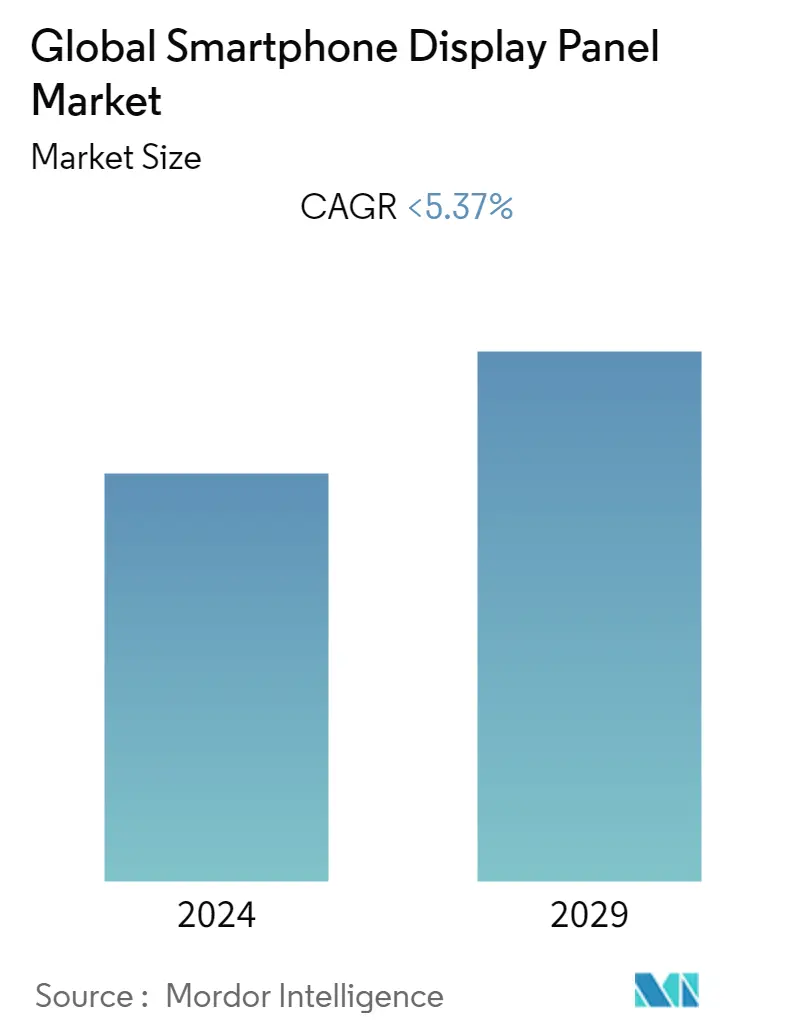
| Study Period | 2019 - 2029 |
| Base Year For Estimation | 2023 |
| Forecast Data Period | 2024 - 2029 |
| Historical Data Period | 2019 - 2022 |
| CAGR | < 5.37 % |
| Market Concentration | High |
Major Players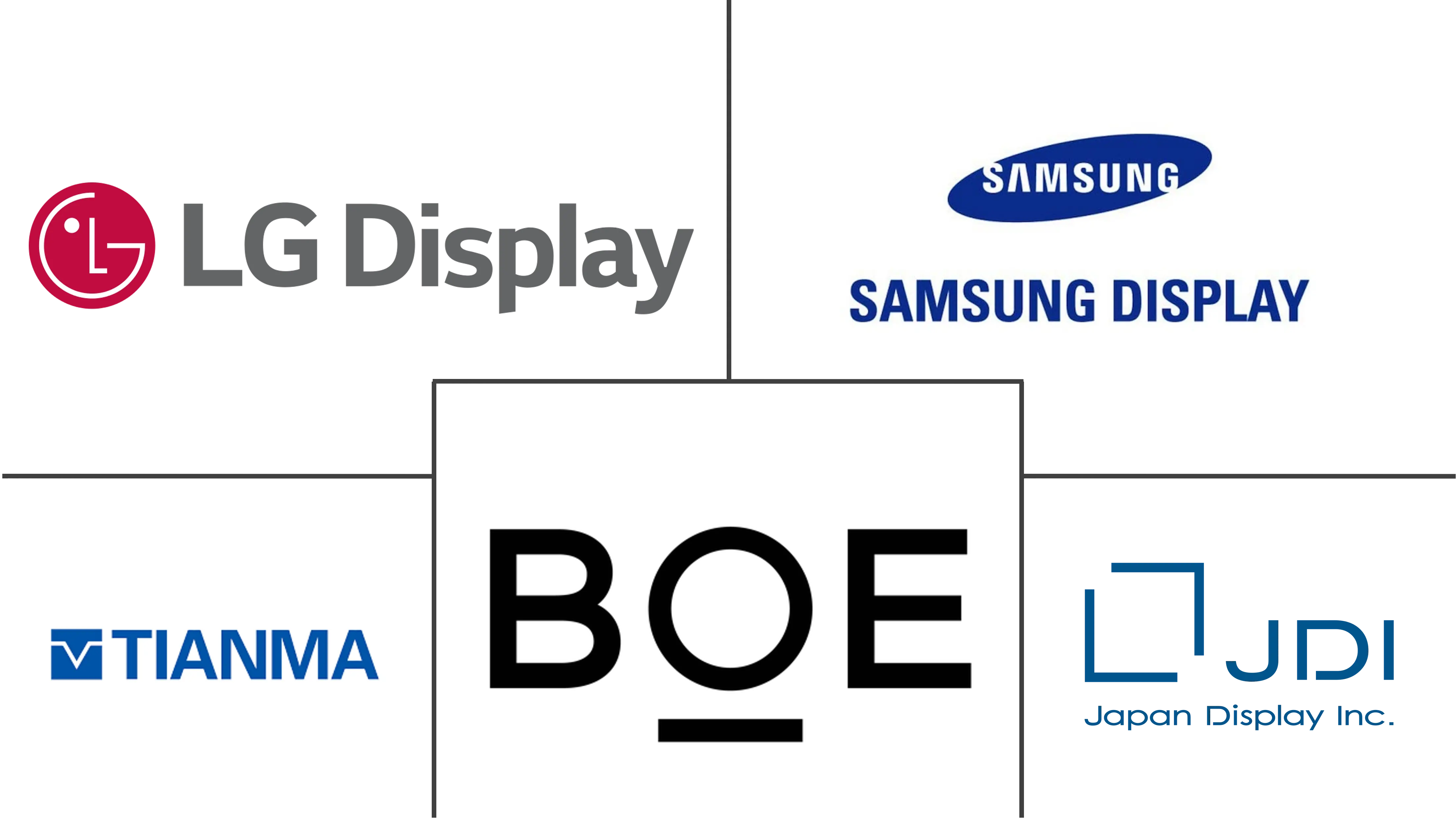
*Disclaimer: Major Players sorted in no particular order |
Need a report that reflects how COVID-19 has impacted this market and its growth?
Smartphone Display Panel Market Analysis
The smartphone display panel market is expected to grow by a CAGR rate of 5.37% in the forecast period. During the financial year 2021, the smartphone display panel market stood at approximately 1.58 billion units, with OLED display panels witnessing a faster growth rate. In terms of vendor market share, Samsung held the prominent share with close to half of the market share and was followed by BOE and LG Display. The significant rise in replacement demand driven by 5G models is expected to propel the market.
- With the availability of UHD content, increasing demand for 4K and 8K displays, increasing use of OLED displays in smartphones, rising demand for flexible display panels, and increasing investments in the construction of new OLED and LCD panel manufacturing facilities.
- The trends such as Work from home and online education have increased the demand for smartphones along with other devices. According to Ericsson Mobile data traffic outlook, the data usage per smartphone was expected to reach 11.4 GB by the end of 2021. Video traffic currently accounts for 69% of all mobile data traffic, with that percentage expected to rise to 79% by 2027, according to the same report. Alongside online viewing, mobile gaming has also increased the usage of smartphones and the demand for smartphones. Therefore a direct impact on the sales of smartphone display panels.
- The growing acceptance of the work-from-home norm, the increasing focus of regional financial institutions on designing fiscal policies to keep the display market afloat during the COVID-19 crisis, and the shifting of manufacturing units to less affected regions such as Vietnam, Korea, Mexico, and other Southeast Asian countries are all factors driving the growth of the post-COVID-19 display panel market.
- To avoid overdependence on China for raw materials, some 200 US corporations are focusing on relocating their manufacturing base from China to India and other Asian countries. Apple, for example, aims to relocate some of its manufacturing plants from China to India to ensure continued production. Wistron, a Taiwanese company, is eyeing India, as well as Vietnam and Mexico. After establishing a new plant in Indonesia, another iPhone assembler, Pegtron, has revealed ambitions to begin manufacturing operations in Vietnam by 2021. By making supply chains more resilient, this technique improves performance and minimizes supply chain risks.
- Other smartphones, such as foldable screens, are also coming into trend. In just two months after its launch in August 2021, the Galaxy Z Fold3 and Flip3 sold over 2 million units around the world. OPPO, a Chinese smartphone manufacturer, released its first foldable flagship smartphone, the OPPO Find N, in December 2021, to mostly excellent reviews. Global smartphone manufacturers are expected to release more flagship foldable phones in the coming years. Furthermore, the introduction of foldable technology is predicted to have a significant impact on the smartphone business, with the worldwide foldable phone market expected to increase at a rate of 21.3% between 2021 and 2027, according to Samsung Display.
Smartphone Display Panel Market Trends
This section covers the major market trends shaping the Smartphone Display Panel Market according to our research experts:
AMOLED LTPO Flexible to drive the market
- LTPO stands for low-temperature polycrystalline oxide. LTPO is an AMOLED backplane technology that allows the best screen technology to unlock a new capability of dynamically refreshing the display. This allows companies to use high refresh rate screens without sacrificing battery life. However, such panels are costlier.
- The biggest advantage of LTPO panels is their variability with refresh rates. Higher refresh rates, though helpful in activities like Gaming, put a toll on the battery life. A continuously high refresh rate will drain the phone battery in no time; therefore, LTPO panels in modern smartphones have to change refresh rates. For instance, The OnePlus 9 Pro supports 120Hz. The 6.7-inch AMOLED panel refreshes at a rate of 1Hz to 120Hz. When performing active stuff like Gaming, it runs at full 120Hz; however, when viewing videos, it switches to 24Hz. The display decreases the refresh rate to 1Hz when the user is viewing a photo or reading text. As a result, the battery life is improved.
- For flagship phones, LTPO technology has become the standard. Some of the first smartphones that used this technology were the OnePlus 9 Pro and Samsung Galaxy S21 Ultra. In 2022, LTPO AMOLED panels will still be found in the premium smartphone market. However, like with all newer technologies, it will eventually filter down to the rest of the market. However, LTPO is not limited to smartphones. Apple Watch Series 5 and later have it.
- Visionox has completed its LTPO R&D project and is ready to begin producing LTPO OLED panels by the end of 2021. In February 2022, however, the company unveiled its first LTPO AMOLED display, which can deliver a dynamic refresh rate of 1Hz to 120Hz. The first phones with these revolutionary displays are expected to be introduced soon, according to Visionox. Visionox's Hefei 6-Gen flexible AMOLED plant produces the latest LTPO AMOLED screens.
- In February 2022 - The iQOO 9 series, which comprises the Qoo 9 Pro, iQOO 9, and iQOO 9 SE, was launched in India, expanding iQOO's offering. Highlights include the flagship Snapdragon 8 Gen 1 processor, Gimbal camera technology, 120Hz refresh rate AMOLED display, and triple rear camera configuration. The display on the iQOO 9 Pro is a 6.78-inch E5 AMOLED with LTPO 2.0 technology.
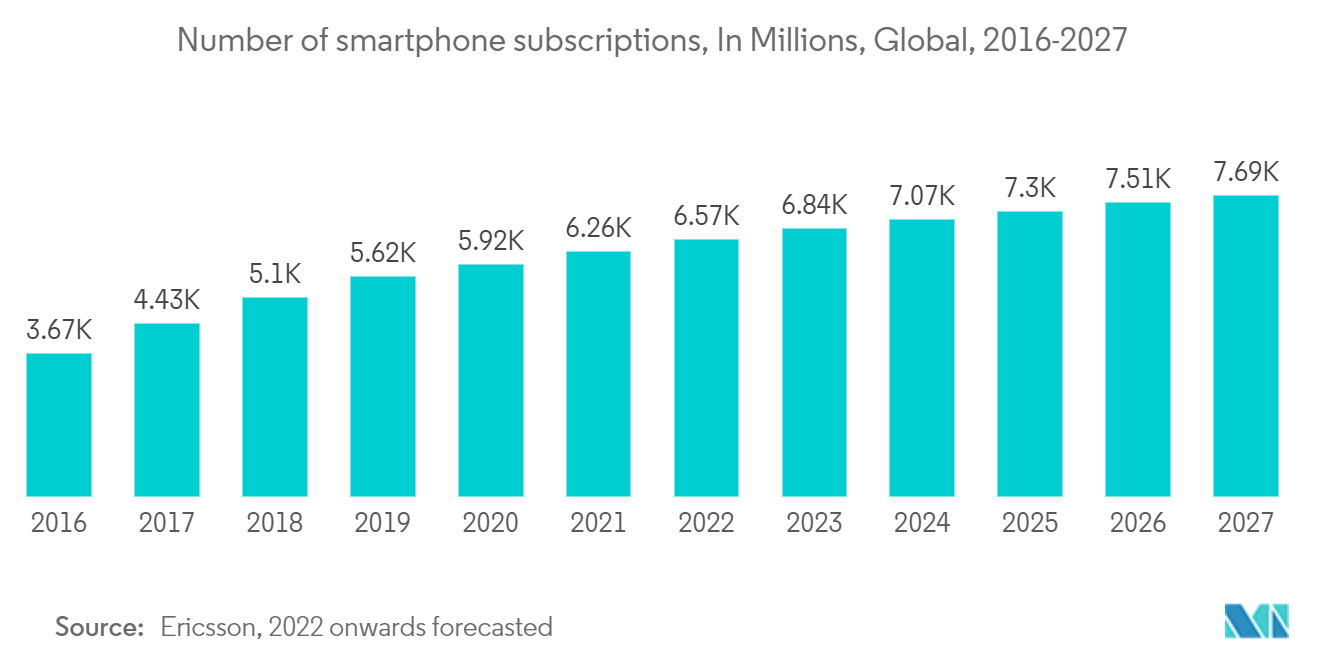
China to hold a significant share in the market
- According to the newest data from a state agency, China's smartphone market recovered last year following a pandemic-induced dip in 2020, albeit total sales have yet to reach 2019 levels. In 2021, China, the world's largest smartphone market, shipped 342.8 million devices to domestic users, up 15.9% from 2020. According to the China Academy of Information and Communications (CAICT), last year's rise contrasted with the sector's poor performance in 2020, when shipments fell 20% year on year to 295.7 million. However, with 372 million smartphones supplied in 2019, shipments in 2021 will fall short of pre-pandemic levels.
- One of the reasons for the rise of the Chinese smartphone display sector is the Chinese government's significant backing of its tech and electrical companies. Chinese enterprises benefit from their large local market as well as hefty government subsidies. The Chinese government has also granted numerous infrastructure and financial benefits. For example, Chinese display producers receive free land, buildings, water, and electricity, and their corporate tax rate is also relatively lower than its set corporate tax or officially known as the Enterprise Income Tax (EIT), which is 25%. They also have zero tariffs on the equipment and supplies they import from other countries. As a result, Chinese display makers have lower production costs than their South Korean counterparts.
- Domestic display panel makers like BOE Technology Group Co Ltd and Visionox Technology Inc are betting big on flexible active-matrix organic LED, or AMOLED, a sort of more flexible OLED. BOE has introduced a variety of world-first and unique flexible display panels, which have been used in premium flagship smartphone devices like Honor's Magic 3 series and Vivo's iQOO 8.
- When BOE Technology built its first 10.5-generation LCD factory in Hefei, China, in 2017, the company contributed only 6.5% of the overall CNY 46 billion (USD 7 billion) invested in the project. The rest came from Hefei city government-owned firms and bank loans backed by government guarantees. According to DB Financial Investments, a major securities firm and investment bank under the DB Group in South Korea, BOE Technology received over CNY 2 trillion (USD 1.7 billion) indirect government subsidies for ten years starting in 2010, accounting for 59% of the company's net income for the decade.
- BOE is apparently working on panels for Samsung Electronics' A13 and A23 cheap smartphone series. Furthermore, Samsung is expected to propose that BOE manufacture the display panels for its next-generation flagship handsets. Samsung Electronics has demanded that BOE validate their technology first because the Samsung flagships employ cutting-edge LTPO technology OLED screens.
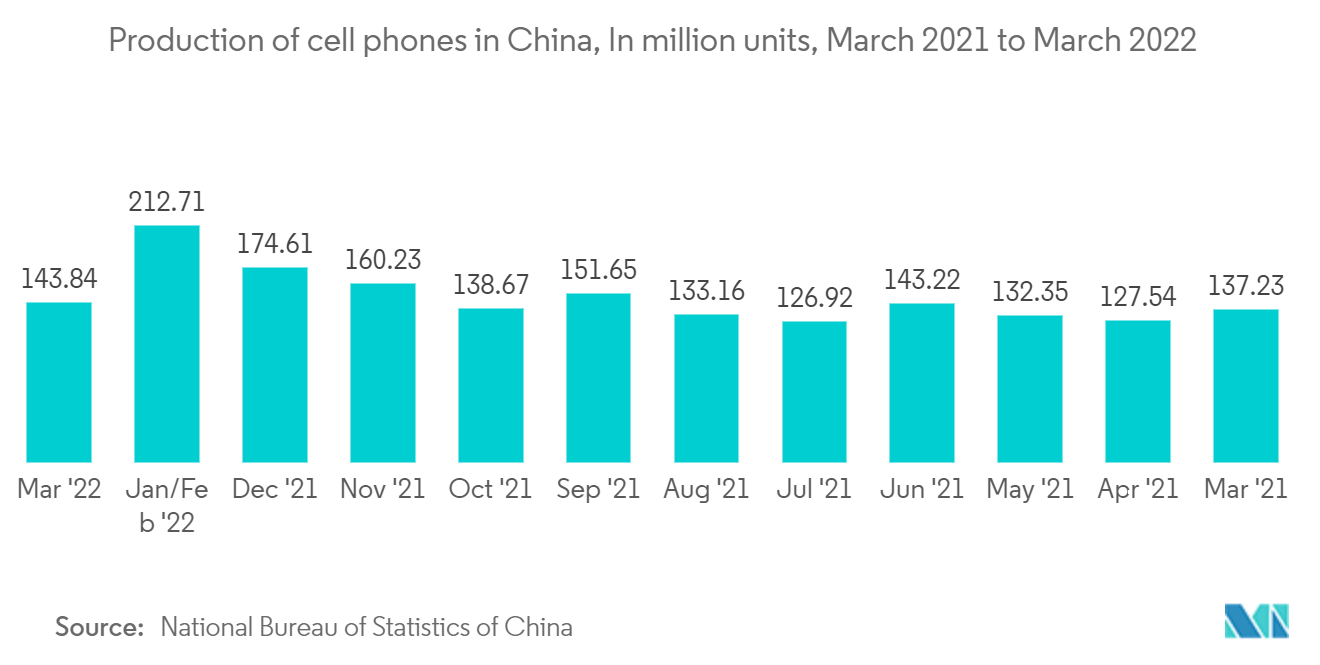
Smartphone Display Panel Industry Overview
The smartphone display panel market is highly concentrated, with a few players like Samsung Display, BOE, and LG Display dominating a major portion of the market. The high technology, Research & development, and high initial development cost in construction and machinery make the market difficult for other vendors to penetrate.
- In December 2021 - Tianma Microelectronics announced a partnership with Xiaomi Corporation at the Wuhan Tianma G6 Industrial Base. The two companies' new alliance will focus on researching and developing innovative display technologies for mobile devices. Both firms have agreed to establish a collaborative laboratory where all display technology research would be conducted.
- In December 2021 - Visionox completed its LTPO research and development project and started producing LTPO OLED displays. This will allow the company to compete in the high-end smartphone display category against Samsung and other major OLED manufacturers.
Smartphone Display Panel Market Leaders
LG Display
Samsung Display
BOE Technology Group Co., Ltd.
TIANMA Group
Japan Display Inc.
*Disclaimer: Major Players sorted in no particular order
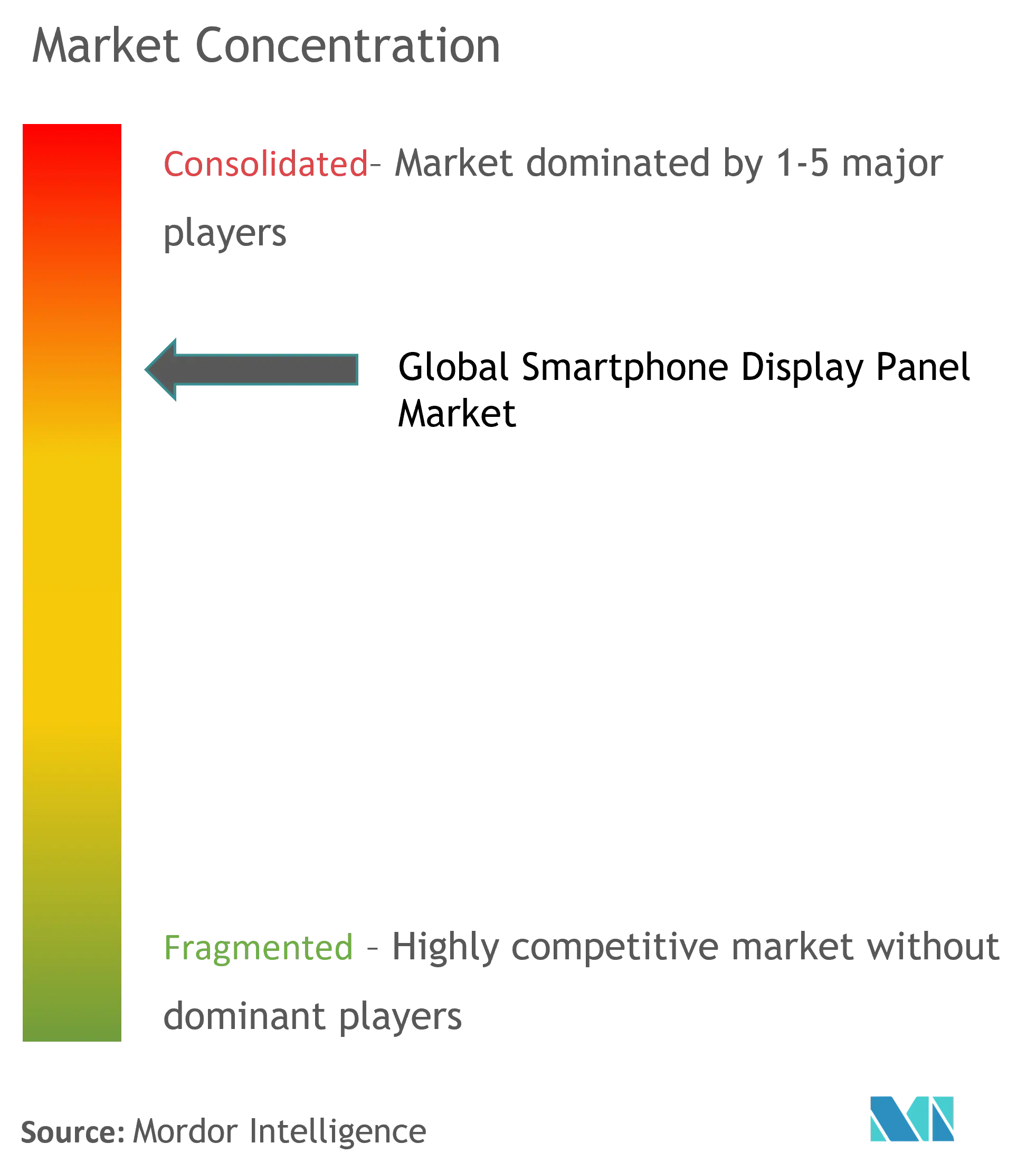
Smartphone Display Panel Market News
- In January 2022 - OnePlus launched the OnePlus 10 Pro with an LTPO 2.0 AMOLED, a progression from last year's panel. The low-temperature polycrystalline oxide display can reduce the frequency to 1Hz for energy savings, and while it wasn't available everywhere last year, the 2.0 version will expand that and boost the battery savings.
- In February 2022 - Vivo launched its flagship smartphone models IQOO 9 Pro and IQOO 9 Sports. The iQOO 9 has a 6.56-inch FHD+ AMOLED display with a refresh rate of up to 120Hz and a touch sampling rate of 300Hz. The iQOO 9 Pro, on the other hand, has a larger 6.78-inch curved AMOLED display with a QHD+ resolution of 3200 x 1440 pixels and LTPO 2.0 technology.
Smartphone Display Panel Market Report - Table of Contents
1. INTRODUCTION
1.1 Study Assumptions and Market Definition
1.2 Scope of the Study
2. RESEARCH METHODOLOGY
3. EXECUTIVE SUMMARY
4. MARKET INSIGHT
4.1 Market Overview
4.2 Industry Attractiveness - Porter's Five Force Analysis
4.2.1 Threat of New Entrants
4.2.2 Bargaining Power of Buyers/Consumers
4.2.3 Bargaining Power of Suppliers
4.2.4 Threat of Substitute Products
4.2.5 Intensity of Competitive Rivalry
4.3 Technological Trends
4.4 Industry Value Chain/Supply Chain Analysis
4.5 Impact of COVID-19 on the Market
5. MARKET DYNAMICS
5.1 Market Drivers
5.2 Market Challenges
6. MARKET SEGMENTATION
6.1 By Technology
6.1.1 TFT LCD LTPS Rigid
6.1.2 TFT LCD a-Si Rigid
6.1.3 AMOLED LTPS Rigid
6.1.4 AMOLED LTPS Flexible
6.1.5 AMOLED LTPO Flexible
6.1.6 TFT LCD Oxide Rigid
6.2 By Geography
6.2.1 United States
6.2.2 China
6.2.3 Japan
6.2.4 South Korea
6.2.5 Rest of the World
7. COMPETITIVE INTELLIGENCE
7.1 LG Display
7.2 Samsung Display
7.3 BOE Technology Group Co. Ltd
7.4 Tianma Group
7.5 Japan Display Inc.
7.6 TCL China Star
7.7 Innolux
7.8 AUO
7.9 Sharp Corporation
7.10 Century
7.11 IVO
8. INVESTMENT ANALYSIS
9. FUTURE OF THE MARKET
Smartphone Display Panel Industry Segmentation
Images are displayed on liquid crystal displays on cell phone screens. Phone LCD screens, like those seen in most TVs and computer monitors, employ an electrical current to alter the color of each pixel. The adoption of huge touch displays transformed the operation and use of mobile phones. In terms of resolution, size, picture quality, and features, today's smartphone displays are remarkable, and the development prospects look to be far from exhausted.
The global smartphone display panel market is segmented by technology (TFT LCD LTPS Rigid, TFT LCD a-Si Rigid, AMOLED LTPS Rigid, AMOLED LTPS Flexible, AMOLED LTPO Flexible, TFT LCD Oxide Rigid) and Geography.
| By Technology | |
| TFT LCD LTPS Rigid | |
| TFT LCD a-Si Rigid | |
| AMOLED LTPS Rigid | |
| AMOLED LTPS Flexible | |
| AMOLED LTPO Flexible | |
| TFT LCD Oxide Rigid |
| By Geography | |
| United States | |
| China | |
| Japan | |
| South Korea | |
| Rest of the World |
Smartphone Display Panel Market Research FAQs
What is the current Global Smartphone Display Panel Market size?
The Global Smartphone Display Panel Market is projected to register a CAGR of less than 5.37% during the forecast period (2024-2029)
Who are the key players in Global Smartphone Display Panel Market?
LG Display, Samsung Display, BOE Technology Group Co., Ltd., TIANMA Group and Japan Display Inc. are the major companies operating in the Global Smartphone Display Panel Market.
What years does this Global Smartphone Display Panel Market cover?
The report covers the Global Smartphone Display Panel Market historical market size for years: 2019, 2020, 2021, 2022 and 2023. The report also forecasts the Global Smartphone Display Panel Market size for years: 2024, 2025, 2026, 2027, 2028 and 2029.
Global Smartphone Display Panel Industry Report
Statistics for the 2024 Global Smartphone Display Panel market share, size and revenue growth rate, created by Mordor Intelligence™ Industry Reports. Global Smartphone Display Panel analysis includes a market forecast outlook to 2029 and historical overview. Get a sample of this industry analysis as a free report PDF download.
